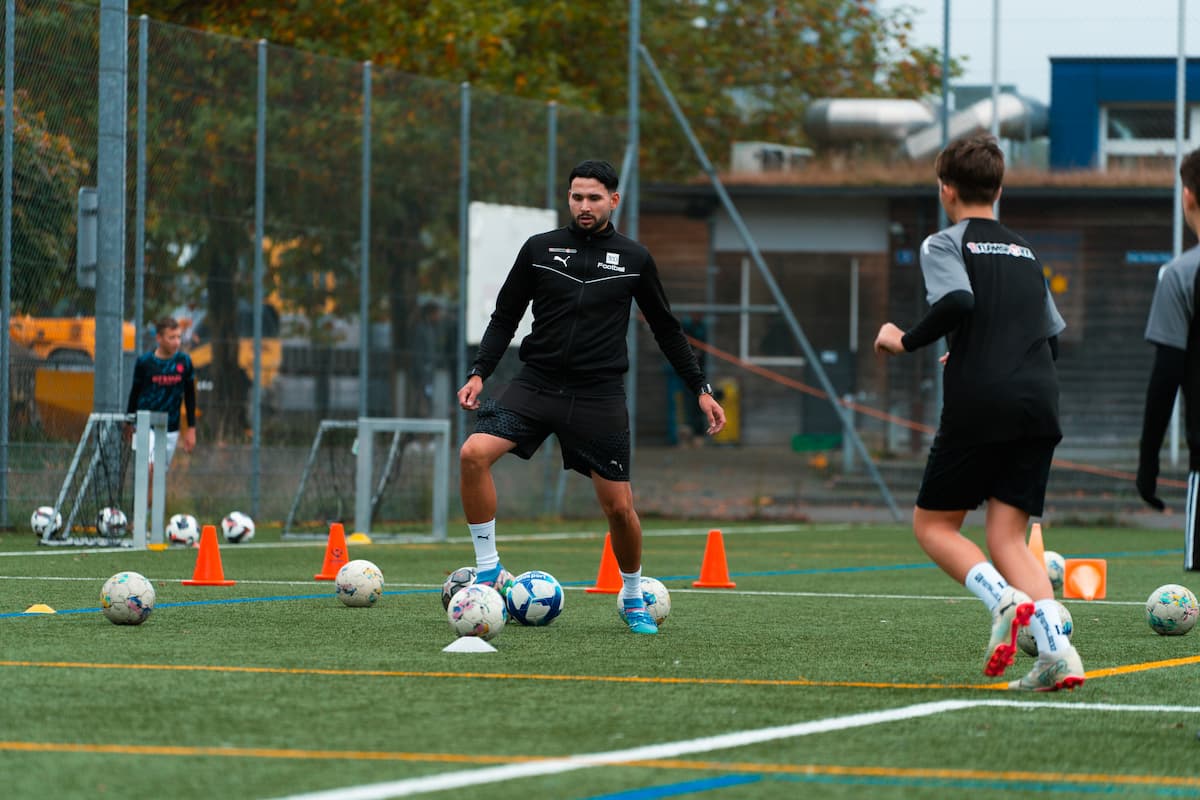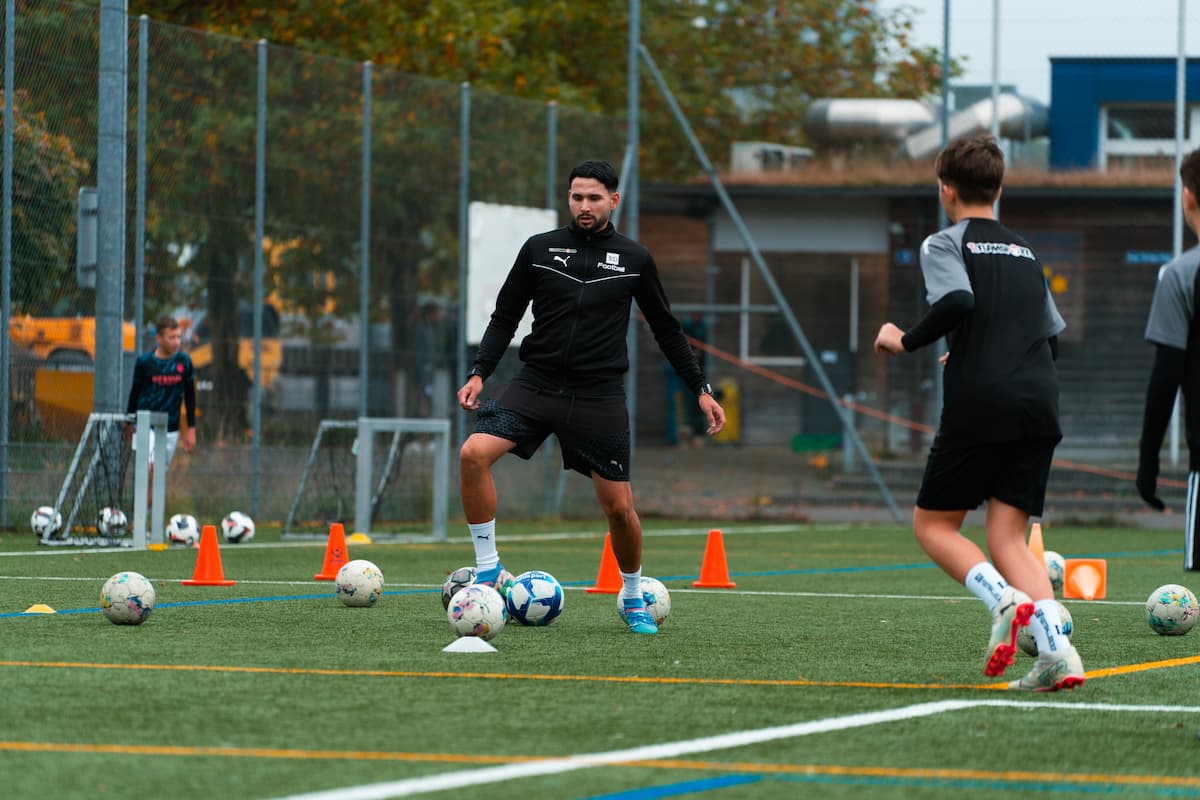The position of the six (central defensive midfielder, CDM) is the linchpin in the football game. Due to the central position, both in width and depth, there are numerous passing routes to the other parts of the team. The defensive midfielder is a key link between the defense and the midfield in the build-up of the game. He supports the full-backs, sets up the wingers and serves as a passing station for strikers who play with their backs to the goal.
Why is the position of the six so important?
A number six has a decisive influence on his team's game. Whether in the build-up, winning the ball or supporting the attack - the number six is one of the most versatile roles in modern football.
Main tasks of a six:
-
distribution of balls in the build-up
-
securing the defense
-
Closing spaces in midfield
-
Initiating attacks through interface passes or game shifts
Different types of players in the six position
The role of the number six is interpreted differently depending on the style of play and the requirements of the coach. Basically, three types of players can be distinguished:
1. Box-to-Box player
The box-to-box player works the field vertically, from penalty area to penalty area. He takes part in actions in the final third, occupies the penalty area for crosses and at the same time ensures stability in the midfield. This player takes on defensive tasks as well as offensive accents.
Tasks of a box-to-box player:
-
Sprint into the back of the defense
-
Occupation of the penalty area during crosses
-
Participation in actions in the last third
-
stability in the important center of the pitch
Characteristics of a box-to-box player:
-
Excellent endurance for high running intensity
-
dynamics in offense and defense
-
Participation in offensive and defensive standard situations
Example: Currently one of the best representatives of this role is Rodri or N'Golo Kanté.
2nd sweeper
A sweeper focuses on playing against the ball. His main tasks are to win back the ball, close gaps and protect against counterattacks. This type of player helps to stabilize the defense by stopping the opponent's attacks early on.
Tasks of a sweeper:
-
protection from counterattacks
-
Closing gaps between lines
-
Occupation of the central space in front of the defense
Characteristics of a sweeper:
-
Outstanding tackling strength
-
Tactical understanding to close spaces effectively
-
Defensive thinking and positional loyalty
Example: Casemiro, formerly of Real Madrid, perfectly demonstrates how a modern sweeper operates by closing defensive gaps and stopping opposing attacks.
3. Tipping Six
The dropping six supports the central defenders in the build-up play by dropping between or next to the defenders. This creates a numerical superiority in the first build-up line, which makes it easier for the team to overcome the opponent's pressing.
Tasks of a tipping six:
-
Supporting the central defenders in the build-up of the game
-
Creating superior numbers in defense
-
Control of the game from deep
Characteristics of a tipping six:
-
Excellent game overview and pass rate
-
Ability to defuse pressure situations in the build-up
-
High precision in long passes and game shifts
Example: Players like Sergio Busquets of FC Barcelona are masters of this role by controlling the game from deep and avoiding opposition pressing.

This blog post will help you shape your team’s game as a tipping six: Centre-back – the “modern” playmaker
Tips for the Six in the Build-Up
Getting into an open position
As already mentioned, the (dropping) six can drop between or to the side of the central defenders to stimulate the build-up of play. In this withdrawn position, you as a six can easily be passed to in an open position.
Challenges and risks:
-
If you hold the midfield and do not drop to the level of the defense, it will be much more difficult for you to be used openly in the direction of play.
-
When building up play, as a number six you always have an opponent behind you. This means that you often only have the option of a back pass or a risky 1-on-1.
-
Losing the ball in your position can cause serious problems because the ball is in a central position and the distances in the build-up play are large.
Possible solutions:
-
Move purposefully into open spaces.
-
Work on your timing to always be ready to play.
Offering against the shift direction
Many number sixes tend to intuitively run towards the centre-back in possession. However, this movement can be counterproductive.
Problem:
-
If you move with the direction of the ball, you run parallel to your opponent and are easy to cover.
-
You also block vertical passing routes of your central defenders.
Alternative:
-
Offer yourself in the opposite direction, i.e. against the shifting movement of your opponent.
-
This allows you to receive the ball in an open position and make use of the space available.

Close to the ball goes, far from the ball comes
If you are not playing alone in defensive midfield, you should coordinate your free-running behavior with the second six.
-
Six close to the ball: Looks for a run into the depth to tie up opponents.
-
Six away from the ball: Uses the gap that has been created to offer himself and take the ball forward.
-
Tip: Instead of coming head-on, move sideways to make it easier to break away from your opponent.

steep clapping game
The steep clap game is an effective method to overplay a line and create dynamism in the build-up to the game.
Process:
-
The central defender plays the ball directly into the depth.
-
After the pass, you immediately move forward and demand the ball from the striker.
-
If you are facing the goal, you can continue the game directly.
Advantages:
-
You outplay several opponents with one action.
-
The pace of construction remains high.

develop resistance to pressure
Why is pressure resistance important?
In the centre of the pitch, where space is tight and pressure is high, the ability to retain possession under pressure becomes crucial. Opposing players will often attack you from multiple directions, requiring you to act quickly and accurately.
Challenges in the Center
-
Time pressure: You have little time to make decisions.
-
Lack of space: The space to control the ball and continue playing is very limited.
-
Pressure from all sides: opponents come from different directions.
key to pressure resistance
1. Ball control
-
Close ball control: Always keep the ball close to your feet so you can react quickly.
-
Ambidexterity: Develop the ability to control the ball safely with both feet in order to react more flexibly to pressure situations.
-
Feints: Use simple tricks like body feints to reduce pressure and open up passing lanes.
2. Overview
-
Scan the playing field: Look around regularly to know the position of teammates and opponents.
-
Anticipatory play: Plan your next pass or action before you receive the ball.
3. Pre-orientation
-
Positioning: Make sure you have an open position to receive the ball.
-
Movement without the ball: Run into open spaces to escape opposition pressure and create better passing options.
Practical exercises for improvement
ball control
-
Dribbling under pressure: Simulate pressure situations in training by playing against several opponents in a confined space.
-
Ambidextrous training: Train systematically with your weak foot to be safe in every situation.
Overview
-
360-degree view: Use training aids such as the Soccerbot360 or simple markings to keep an eye on the field at all times. Or train specifically with a personal trainer. You can book specific training sessions at 360Football.
pre-orientation
-
Simulated game situations: Work with training partners who put you under pressure while you take and carry the ball.
-
Passing and clapping exercises: Play the ball against a wall to practice quick ball reception and passing.
Examples of Pressing Resistance
-
Sergio Busquets: Known for his ability to keep the ball under enormous pressure, he is a prime example of pressing resistance. His movements are minimal but efficient, and he always keeps an overview.
-
Thiago Alcântara: With his close ball control and overview, he manages to play dangerous passes even in the tightest spaces and organize his team's game.
Conclusion
Resistance to pressure is an essential skill for any number six who wants to play at the highest level. With targeted training in the areas of ball control, overview and pre-orientation, you can assert yourself under pressure and have a significant influence on your team's game. Use the tips and exercises described above to further develop your skills and act calmly and effectively even under pressure.
About the author:
Luis Österlein (Twitter: LOsterlein ) is a game analyst for FC Bayern Munich's U23 team and a freelance author. In close collaboration with 360Football, he writes specific blog posts that support players in their football development support.
Non-binding registration for an initial consultation (100% free) with 360Football for football performance optimization.
For a free initial consultation, as well as for individual inquiries about individual training, goalie training, training programs, nutritional advice, video, game analysis or mental and athletic training , use the form below.


